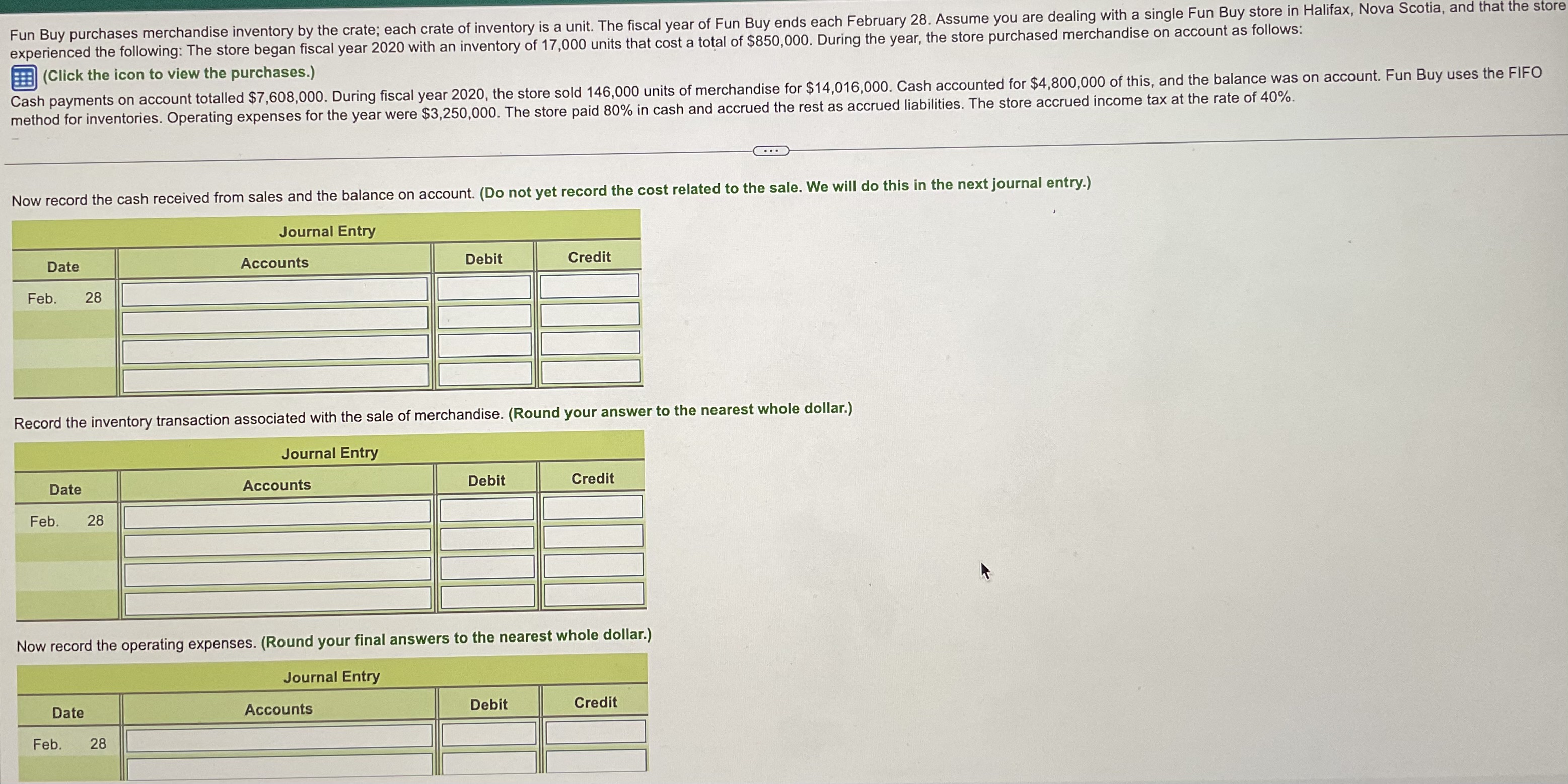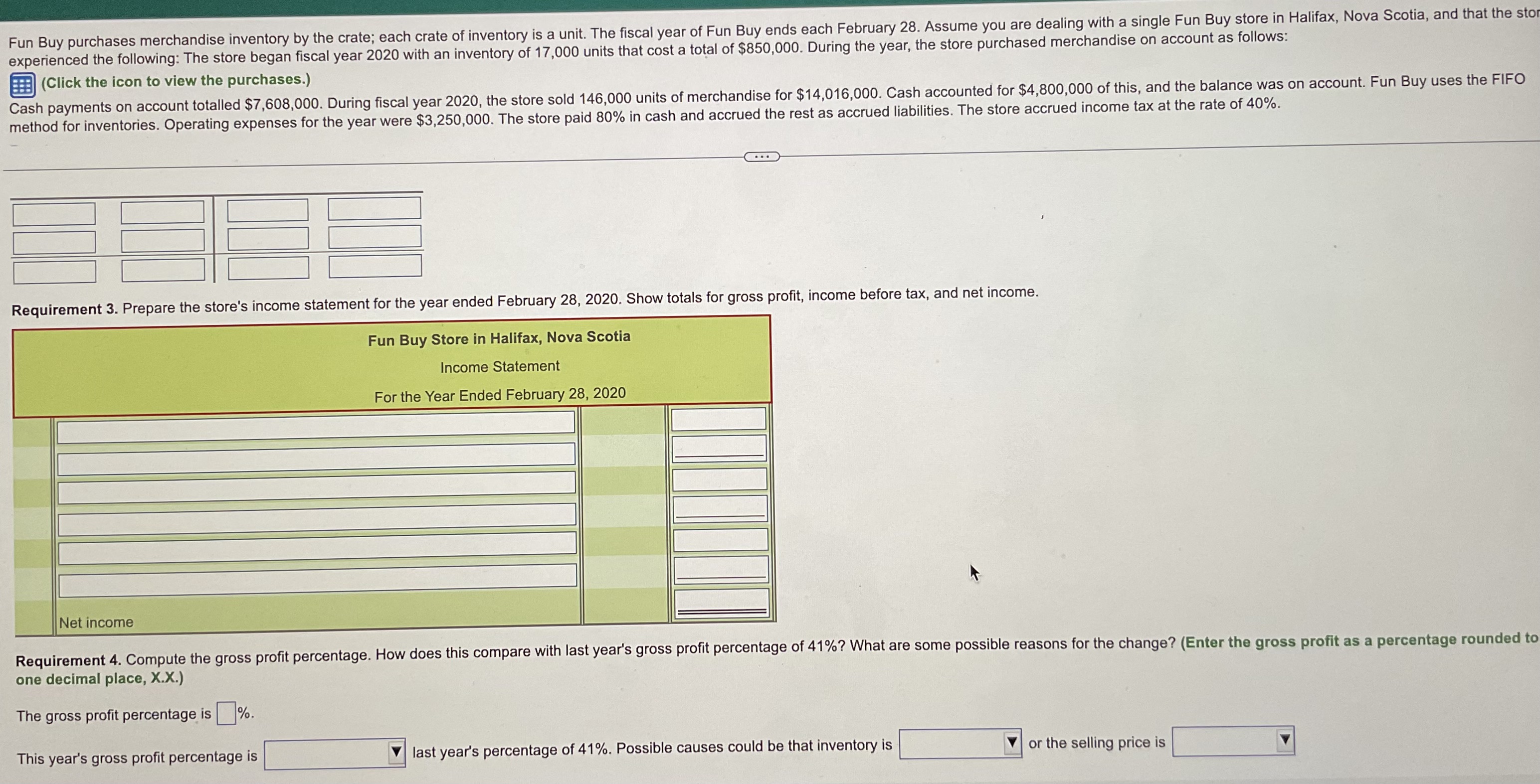Answered step by step
Verified Expert Solution
Question
1 Approved Answer
Fun Buy purchases merchandise inventory by the crate; each crate of inventory is a unit. The fiscal year of Fun Buy ends each February




Fun Buy purchases merchandise inventory by the crate; each crate of inventory is a unit. The fiscal year of Fun Buy ends each February 28. Assume you are dealing with a single Fun Buy store in Halifax, Nova Scotia, and that the store experienced the following: The store began fiscal year 2020 with an inventory of 17,000 units that cost a total of $850,000. During the year, the store purchased merchandise on account as follows: (Click the icon to view the purchases.) Cash payments on account totalled $7,608,000. During fiscal year 2020, the store sold 146,000 units of merchandise for $14,016,000. Cash accounted for $4,800,000 of this, and the balance was on account. Fun Buy uses the FIFO method for inventories. Operating expenses for the year were $3,250,000. The store paid 80% in cash and accrued the rest as accrued liabilities. The store accrued income tax at the rate of 40%. Requirement 1. Make summary journal entries to record the store's transactions for the year ended February 28, 2020. Fun Buy uses a perpetual inventory system. Let's start with the entry to record the purchases. (Record debits first, then credits. Explanations are not required.) Journal Entry Date Feb. 28 Next, record the cash payments on account. Date Feb. Accounts 28 Date Journal Entry Accounts Debit Accounts Debit Credit Debit Credit Now record the cash received from sales and the balance on account. (Do not yet record the cost related to the sale. We will do this in the next journal entry.) Journal Entry Purchases Credit April (28,000 units @ cost of $54). August (48,000 units @ cost of $58) November (58,000 units @ cost of $64) .. Total purchases. Print Done SPYUR $ 1,512,000 2,784,000 3,712,000 $ 8,008,000 X Fun Buy purchases merchandise inventory by the crate; each crate of inventory is a unit. The fiscal year of Fun Buy ends each February 28. Assume you are dealing with a single Fun Buy store in Halifax, Nova Scotia, and that the store experienced the following: The store began fiscal year 2020 with an inventory of 17,000 units that cost a total of $850,000. During the year, the store purchased merchandise on account as follows: (Click the icon to view the purchases.) Cash payments on account totalled $7,608,000. During fiscal year 2020, the store sold 146,000 units of merchandise for $14,016,000. Cash accounted for $4,800,000 of this, and the balance was on account. Fun Buy uses the FIFO method for inventories. Operating expenses for the year were $3,250,000. The store paid 80% in cash and accrued the rest as accrued liabilities. The store accrued income tax at the rate of 40%. Now record the cash received from sales and the balance on account. (Do not yet record the cost related to the sale. We will do this in the next journal entry.) Journal Entry Date Feb. 28 Date Feb. Record the inventory transaction associated with the sale of merchandise. (Round your answer to the nearest whole dollar.) Journal Entry Date 28 Feb. Accounts 28 Accounts Debit Now record the operating expenses. (Round your final answers to the nearest whole dollar.) Journal Entry Accounts Debit Credit Debit Credit Credit Fun Buy purchases merchandise inventory by the crate; each crate of inventory is a unit. The fiscal year of Fun Buy ends each February 28. Assume you are dealing with a single Fun Buy store in Halifax, Nova Scotia, and that the store experienced the following: The store began fiscal year 2020 with an inventory of 17,000 units that cost a total of $850,000. During the year, the store purchased merchandise on account as follows: (Click the icon to view the purchases.) Cash payments on account totalled $7,608,000. During fiscal year 2020, the store sold 146,000 units of merchandise for $14,016,000. Cash accounted for $4,800,000 of this, and the balance was on account. Fun Buy uses the FIFO method for inventories. Operating expenses for the year were $3,250,000. The store paid 80% in cash and accrued the rest as accrued liabilities. The store accrued income tax at the rate of 40%. Finally, record the entry to accrue income tax. (Round your final answers to the nearest whole dollar.) Journal Entry Date Feb. 28 Accounts Debit Inventory Credit Requirement 2. Prepare a T-account to show the activity in the Inventory account. Post the beginning balance and activity to the T-account, and calculate the ending inventory balance. (Abbreviation used: COGS = cost of goods sold. Leave any unused cells blank.) Requirement 3. Prepare the store's income statement for the year ended February 28, 2020. Show totals for gross profit, income before tax, and net income. Fun Buy Store in Halifax, Nova Scotia Income Statement For the Year Ended February 28, 2020 Fun Buy purchases merchandise inventory by the crate; each crate of inventory is a unit. The fiscal year of Fun Buy ends each February 28. Assume you are dealing with a single Fun Buy store in Halifax, Nova Scotia, and that the stor experienced the following: The store began fiscal year 2020 with an inventory of 17,000 units that cost a total of $850,000. During the year, the store purchased merchandise on account as follows: (Click the icon to view the purchases.) Cash payments on account totalled $7,608,000. During fiscal year 2020, the store sold 146,000 units of merchandise for $14,016,000. Cash accounted for $4,800,000 of this, and the balance was on account. Fun Buy uses the FIFO method for inventories. Operating expenses for the year were $3,250,000. The store paid 80% in cash and accrued the rest as accrued liabilities. The store accrued income tax at the rate of 40%. Requirement 3. Prepare the store's income statement for the year ended February 28, 2020. Show totals for gross profit, income before tax, and net income. Fun Buy Store in Halifax, Nova Scotia Income Statement For the Year Ended February 28, 2020 Net income Requirement 4. Compute the gross profit percentage. How does this compare with last year's gross profit percentage of 41%? What are some possible reasons for the change? (Enter the gross profit as a percentage rounded to one decimal place, X.X.) The gross profit percentage is %. This year's gross profit percentage is last year's percentage of 41%. Possible causes could be that inventory is or the selling price is
Step by Step Solution
There are 3 Steps involved in it
Step: 1
Requirement 1 Journal Entries Entry to record purchases Date April Accounts Debit Credit Purchases 1...
Get Instant Access to Expert-Tailored Solutions
See step-by-step solutions with expert insights and AI powered tools for academic success
Step: 2

Step: 3

Ace Your Homework with AI
Get the answers you need in no time with our AI-driven, step-by-step assistance
Get Started


